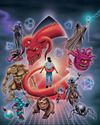
IN THE AUTUMN of 1918, as the second wave of the deadly influenza epidemic that had been rampaging across the world reached the U.S., people started staying away from movie theaters. Soon, as more people got sick, local authorities would order them shuttered. In many cases, theater owners would assent to the closure with what one Boston trade organization at the time called “cheerful compliance.” Within a few weeks, though, as the epidemic’s urgency waned, owners began to get restive. They were losing money and wanted to get back to selling tickets. A few managers were arrested for defying shutdown orders. Gradually, compromises began to emerge: Sometimes theaters were able to get by with alternate-row seating or by making masks available for patrons.
Of course, nobody sheltering in place in 1918 had the option of sitting at home and streaming on the sofa. Movie houses were the only place to see movies, and movies were still pretty new and among the few entertainment options available to people. So once the threat began to fade, people flocked back. Today, even before the coronavirus pandemic closed the cinemas, big changes were underway in the industry. The traditional procession of movies through a sacrosanct “theatrical window”—when you have to get off the sofa and go to the multiplex and buy a ticket to see it—has been under pressure from the rise of vertically integrated streaming giants trying to rush their films onto new platforms. In the wake of this pandemic, are movie theaters, having long since lost their essential place in our culture, going to become relics of the past?
Esta historia es de la edición May 25 - June 07, 2020 de New York magazine.
Comience su prueba gratuita de Magzter GOLD de 7 días para acceder a miles de historias premium seleccionadas y a más de 9,000 revistas y periódicos.
Ya eres suscriptor ? Conectar
Esta historia es de la edición May 25 - June 07, 2020 de New York magazine.
Comience su prueba gratuita de Magzter GOLD de 7 días para acceder a miles de historias premium seleccionadas y a más de 9,000 revistas y periódicos.
Ya eres suscriptor? Conectar

LIFE AS A MILLENNIAL STAGE MOM
A journey into the CUTTHROAT and ADORABLE world of professional CHILD ACTORS.

THE NEXT DRUG EPIDEMIC IS BLUE RASPBERRY FLAVORED
When the Amor brothers started selling tanks of flavored nitrous oxide at their chain of head shops, they didn't realize their brand would become synonymous with the country's burgeoning addiction to gas.

Two Texans in Williamsburg
David Nuss and Sarah Martin-Nuss tried to decorate their house on their own— until they realized they needed help: Like, how do we not just go to Pottery Barn?”

ADRIEN BRODY FOUND THE PART
The Brutalist is the best, most personal work he's done since The Pianist.

Art, Basil
Manuela is a farm-to-table gallery for hungry collectors.

'Sometimes a Single Word Is Enough to Open a Door'
How George C. Wolfein collaboration with Audra McDonald-subtly, indelibly reimagined musical theater's most domineering stage mother.

Rolling the Dice on Bird Flu
Denial, resilience, déjà vu.

The Most Dangerous Game
Fifty years on, Dungeons & Dragons has only grown more popular. But it continues to be misunderstood.

88 MINUTES WITH...Andy Kim
The new senator from New Jersey has vowed to shake up the political Establishment, a difficult task in Trump's Washington.

Apex Stomps In
The $44.6 million mega-Stegosaurus goes on view (for a while) at the American Museum of Natural History.